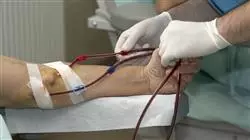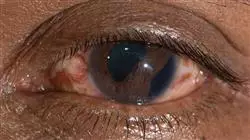University certificate
The world's largest faculty of nursing”
Introduction to the Program
Improve your knowledge through this program, where you will find the best didactic material with real clinical cases. Learn here about the latest advances in the specialty to be able to perform a quality nursing practice"

Nursing plays a decisive role in the care of the patient with chronic kidney disease, both from its onset and in later stages. In addition to skills in renal replacement techniques such as the acquisition of specific professional competencies, specific and quality care is required in the various studies of renal disease.
The care of the nephrological patient, including renal function replacement techniques, has made significant advances in recent years, both in terms of renal transplantation and the health care of the nephrological patient, requiring specialized and continuous training for nurses. Such specialized training is rarely found in standard curricular training, so many nurses are unaware of important aspects of caring for these patients. Training in this area is necessary to guarantee a minimum quality of care.
Increase your competencies in the approach to Hemodialysis for Nursing through this program"
This Postgraduate certificate in Hemodialysis for Nursing contains the most complete and up-to-date scientific program on the market. The most important features include:
- Development of clinical cases presented by experts in nephrology nursing. The graphic, schematic, and eminently practical contents with which they are created, provide scientific and practical information on the disciplines that are essential for professional practice
- Diagnostic and therapeutic developments on the performance in Hemodialysis for Nursing
- An algorithm-based interactive learning system for decision-making in the clinical situations presented throughout the course
- With a special emphasis on evidence-based medicine and nursing research methodologies in the renal patient
- All of this will be complemented by theoretical lessons, questions to the expert, debate forums on controversial topics, and individual reflection assignments
- Content that is accessible from any fixed or portable device with an Internet connection
This Postgraduate certificate may be the best investment you can make when choosing a refresher program for two reasons: in addition to updating your knowledge in Hemodialysis for Nursing, you will obtain a certificate from TECH Global University"
Its teaching staff includes health professionals in the field of nephrological nursing, who bring to this training the experience of their work, in addition to recognized specialists belonging to scientific societies of reference.
The multimedia content developed with the latest educational technology will provide the professional with situated and contextual learning, i.e., a simulated environment that will provide an immersive training program to train in real situations.
Problem-Based Learning underpins this program design, and the doctor must use it to try and solve the different professional practice situations that arise throughout the University Course. This will be done with the help of an innovative interactive video system developed by recognized experts in the field of nephrology nursing with extensive teaching experience.
The Postgraduate certificate includes real clinical cases and exercises to bring the development of the course closer to the practice of the nurse who provides care to renal patients"

Make the most of this opportunity to update your knowledge in Hemodialysis and improve your patient care"
Why study at TECH?
TECH is the world’s largest online university. With an impressive catalog of more than 14,000 university programs available in 11 languages, it is positioned as a leader in employability, with a 99% job placement rate. In addition, it relies on an enormous faculty of more than 6,000 professors of the highest international renown.

Study at the world's largest online university and guarantee your professional success. The future starts at TECH”
The world’s best online university according to FORBES
The prestigious Forbes magazine, specialized in business and finance, has highlighted TECH as “the world's best online university” This is what they have recently stated in an article in their digital edition in which they echo the success story of this institution, “thanks to the academic offer it provides, the selection of its teaching staff, and an innovative learning method aimed at educating the professionals of the future”
A revolutionary study method, a cutting-edge faculty and a practical focus: the key to TECH's success.
The most complete study plans on the university scene
TECH offers the most complete study plans on the university scene, with syllabuses that cover fundamental concepts and, at the same time, the main scientific advances in their specific scientific areas. In addition, these programs are continuously being updated to guarantee students the academic vanguard and the most in-demand professional skills. In this way, the university's qualifications provide its graduates with a significant advantage to propel their careers to success.
TECH offers the most comprehensive and intensive study plans on the current university scene.
A world-class teaching staff
TECH's teaching staff is made up of more than 6,000 professors with the highest international recognition. Professors, researchers and top executives of multinational companies, including Isaiah Covington, performance coach of the Boston Celtics; Magda Romanska, principal investigator at Harvard MetaLAB; Ignacio Wistumba, chairman of the department of translational molecular pathology at MD Anderson Cancer Center; and D.W. Pine, creative director of TIME magazine, among others.
Internationally renowned experts, specialized in different branches of Health, Technology, Communication and Business, form part of the TECH faculty.
A unique learning method
TECH is the first university to use Relearning in all its programs. It is the best online learning methodology, accredited with international teaching quality certifications, provided by prestigious educational agencies. In addition, this disruptive educational model is complemented with the “Case Method”, thereby setting up a unique online teaching strategy. Innovative teaching resources are also implemented, including detailed videos, infographics and interactive summaries.
TECH combines Relearning and the Case Method in all its university programs to guarantee excellent theoretical and practical learning, studying whenever and wherever you want.
The world's largest online university
TECH is the world’s largest online university. We are the largest educational institution, with the best and widest online educational catalog, one hundred percent online and covering the vast majority of areas of knowledge. We offer a large selection of our own degrees and accredited online undergraduate and postgraduate degrees. In total, more than 14,000 university degrees, in eleven different languages, make us the largest educational largest in the world.
TECH has the world's most extensive catalog of academic and official programs, available in more than 11 languages.
Google Premier Partner
The American technology giant has awarded TECH the Google Google Premier Partner badge. This award, which is only available to 3% of the world's companies, highlights the efficient, flexible and tailored experience that this university provides to students. The recognition as a Google Premier Partner not only accredits the maximum rigor, performance and investment in TECH's digital infrastructures, but also places this university as one of the world's leading technology companies.
Google has positioned TECH in the top 3% of the world's most important technology companies by awarding it its Google Premier Partner badge.
The official online university of the NBA
TECH is the official online university of the NBA. Thanks to our agreement with the biggest league in basketball, we offer our students exclusive university programs, as well as a wide variety of educational resources focused on the business of the league and other areas of the sports industry. Each program is made up of a uniquely designed syllabus and features exceptional guest hosts: professionals with a distinguished sports background who will offer their expertise on the most relevant topics.
TECH has been selected by the NBA, the world's top basketball league, as its official online university.
The top-rated university by its students
Students have positioned TECH as the world's top-rated university on the main review websites, with a highest rating of 4.9 out of 5, obtained from more than 1,000 reviews. These results consolidate TECH as the benchmark university institution at an international level, reflecting the excellence and positive impact of its educational model.” reflecting the excellence and positive impact of its educational model.”
TECH is the world’s top-rated university by its students.
Leaders in employability
TECH has managed to become the leading university in employability. 99% of its students obtain jobs in the academic field they have studied, within one year of completing any of the university's programs. A similar number achieve immediate career enhancement. All this thanks to a study methodology that bases its effectiveness on the acquisition of practical skills, which are absolutely necessary for professional development.
99% of TECH graduates find a job within a year of completing their studies.
Postgraduate Certificate in Hemodialysis for Nursing
Chronic kidney disease causes the kidneys to not function properly, which makes it necessary to use procedures such as hemodialysis (HD); a fundamental technique that helps the body to filter toxins and water from the blood. This treatment is only carried out by qualified health personnel, however, the developments that have arisen in the sector have caused professionals to continuously train to learn the latest tools used in said procedure. Against this background, TECH Global University developed a Postgraduate Certificate in Hemodialysis for Nursing that covers the main differential characteristics and techniques currently used (high-flow and home hemodialysis). Through this 200-hour online program, students will specialize in optimizing the quality and care of nephrology patients, in order to provide them with a satisfactory recovery and comprehensive well-being. In addition, they will have unique academic material that includes everything from fundamental approach techniques to the ideal care that a user should receive in regular clinical practice.
He is studying a postgraduate Postgraduate Certificate on the hemodialysis procedure
According to the EPIRCE study (Epidemiology of Chronic Renal Failure in Spain), it is estimated that approximately 10% of the adult population suffers from some degree of chronic kidney disease, which requires that the nursing staff develop the necessary skills to treat this pathology through hemodialysis. In this program offered by the largest digital university in the world, students will find the most up-to-date academic agenda in the industry. Due to this, they will be specialists in managing renal function replacement techniques, both in cases of a traditional nature, and in patients with transplants who require individualized healthcare. In the same way, each one will understand the types of dialyzers and their liquids supplied in ideal doses (Kt, Kt/V and clearance of molecules); followed by surgical techniques and proper handling of the monitors (assembly, priming, connection, disconnection and disinfection). After completing the Postgraduate Certificate, students will obtain the necessary skills to deal with any diagnostic-therapeutic novelty that arises during the development of the procedure.







